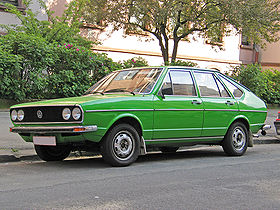Volkswagen Passat (B1)
| Volkswagen Passat (B1) | |
|---|---|

Volkswagen Passat (B1)
|
|
| Overview | |
| Also called | Volkswagen Dasher |
| Production | 1973–1981 (1974–1988 in Brazil) |
| Assembly |
Emden, Germany São Bernardo do Campo, Brazil Clayton, Victoria, Australia (1974–1977) |
| Designer | Giorgetto Giugiaro |
| Body and chassis | |
| Class | Mid-size car / Large family car (D) |
| Body style | 2-door saloon/sedan 3-door hatchback 4-door saloon/sedan 5-door hatchback 5-door estate/wagon |
| Layout | Front engine, front-wheel drive |
| Platform | Volkswagen Group B1 |
| Related | Audi 80/Fox |
| Powertrain | |
| Engine | 1.3 L I4 1.5 L I4 1.6 L I4 1.5 L I4 diesel engine |
| Transmission | 4/5-speed manual |
| Dimensions | |
| Wheelbase | 2,470 mm (97 in) |
| Length | 4,190 mm (165 in) |
| Width | 1,600 mm (63 in) |
| Height | 1,360 mm (54 in) |
| Chronology | |
| Successor | Volkswagen Passat (B2) |
The Volkswagen Passat (B1) is an automobile produced by Volkswagen in Germany from 1973 to 1981.
The original Volkswagen Passat was launched in 1973. The body types offered originally were two- and four-door fastback sedans and identically profiled three- and five-door versions. Externally all four shared a modern design, styled by the Italian designer Giorgetto Giugiaro. In essence, the first Passat was a fastback version of the mechanically identical Audi 80 sedan, introduced a year earlier. A five-door station wagon/estate was introduced in 1974. In Europe, the Passat was equipped with either two rectangular, two round 7-inch (180 mm) units, or quadruple round 5.5-inch (140 mm) headlights depending on specification. The Passat was one of the most modern European family cars at the time, and was intended as a replacement for the aging Volkswagen Type 3 and Type 4. The Passat was Wheels magazine's Car of the Year for 1974 and its sister model Audi 80 was nominated car of the year by the European motor press a year earlier. The platform was named B1.
The Passat originally used the four-cylinder OHC 1.3 l (55 PS or 40 kW or 54 hp) and 1.5 l (with either 75 or 85 PS, 55 or 63 kW or 74 or 84 hp) petrol engines also used in the Audi 80—longitudinally mounted with front-wheel drive, in Audi tradition, with either a four-speed manual transmission or three-speed automatic. It had a MacPherson strut front suspension with a solid axle/coil spring setup at the rear.
...
Wikipedia
